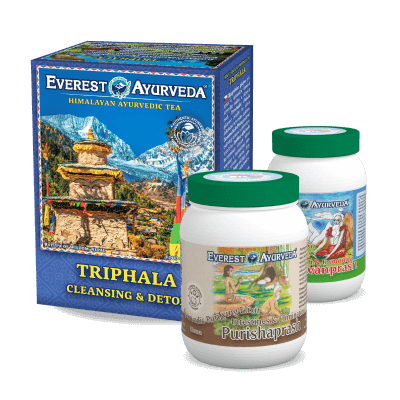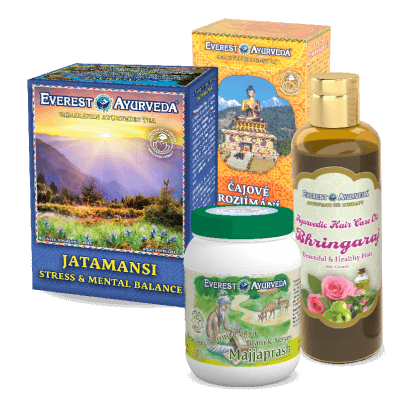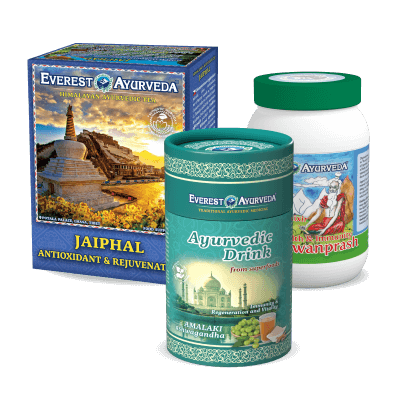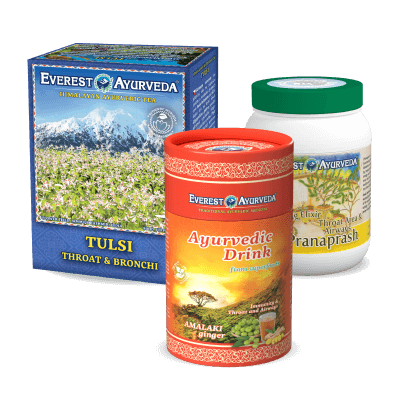
Ayurvedic medicine involves both making a correct diagnosis and determining the appropriate treatment (chikitsa) to heal the physical body, mind and consciousness.
It is first necessary to discover the original individual constitution of the person (prakrti), then determine the current state of imbalance of the individual doshas (vikrti), find out the cause of their disturbance in the form of impaired health or disease, and then choose an adequate remedy. The basic assumption for successful treatment is to first establish an appropriate daily regimen (dinacharya) and then choose between two methods, either calming home therapy (shamana) or purifying clinical therapy (shodhana) under the guidance of an Ayurvedic doctor. To maintain constitutional balance and good health, the therapeutic recommendations of Ayurvedic diet (ahara) and lifestyle (vihara) should be followed along with regular self-massage with warm oil (abhyanga). The final phase of Ayurvedic care is a rejuvenation and revitalization therapy (rasayana), which strengthens the immune system and overall vitality of the body (ojas).
Six Stages of the Disease
If we can recognise the different stages that a disease goes through at its onset, it will be much easier for us to prevent it from manifesting or progressing further. In the first three stages (accumulation, irritation, dissemination), the disease announces itself with subtle symptoms that one is either unaware of or simply pays no attention to. If we fail to detect and address these initial signs of imbalance in time, the disease then progresses to the next three phases (displacement, manifestation, disturbance), when the full-blown disease is already present.
The disease itself arises first on account of the accumulation of a single dosha vata, pitta or kapha in a particular point of the digestive system according to its location. Vata is found in the large intestine, pitta in the stomach, small intestine and liver, kapha in the digestive tract and airways. Subsequently, there is irritation of the organs associated with each area where each dosha acts. In these first two stages, the onset of disease can still be easily prevented by modifying the diet and taking appropriate herbs. Once the dosha begins to spread to the peripheral tissues (plasma, blood, skin), that is when it progresses to its third stage. In the fourth stage, it then begins to move into the internal tissues of the physical body (muscle, fat, nerves, bone and reproductive tissue). From there, in the fifth stage, it moves to the central organ areas, where it manifests and establishes itself (brain, heart, lungs, liver, kidneys and reproductive system). Up to this stage, the disease can be reversed with herbal remedies. In the final sixth stage, a serious illness occurs in the form of chronic disruption of some of our vital functions.
Find out the Dosha therapies that regulate elevated doshas of vata, pitta or kapha. To make the right choice, it is necessary to know your doshic constitution. If you don't know it yet, take a simple Dosha test online!
Ayurvedic Healing Practices
Both forms of therapies (shamana/shodhana) include the six main techniques of Ayurvedic treatment (chikitsa):
- Reduction therapy (langhana) is designed to reduce excess kapha dosha, which, when accumulated, causes excessive fat and weight gain with all the other health consequences.
- Nutritional therapy (bruhmana) aims at increasing kapha dosha in cases of disturbed vata or pitta dosha.
- Drying therapy (rukshana) eliminates increased kapha dosha, removes fat and cholesterol from the body, reduces body weight and promotes weight loss.
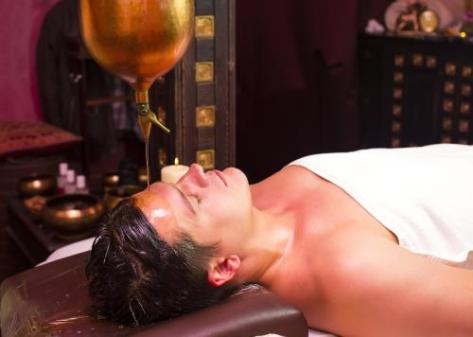
- Oil therapies (snehana) regenerate and rejuvenate the skin, reduce feelings of tension and stress, contribute to physical relaxation and mental health of all three doshas. Among the most well-known are full-body oil massage (abhyanga), application of a continuous stream of warm oil to the forehead (shirodhara), or scalp oil bath (shiro-basti).
- Sweat therapy (savasana) dispels cold and stiffness, heals the respiratory tract, improves circulation, warms bodily tissues and helps remove toxins. It is applied for vata and kapha dosha imbalances.
- Stabilization therapy (stambhana) reduces increased vata and pitta dosha, is applied for insomnia, instability and mental instability. It has a positive astringent effect in diarrhea and heavy menstrual bleeding. It reduces the flow of blood, lymph and other bodily fluids.
Ayurvedic Health Therapies
Ayurvedic health treatments are the most effective form of Ayurvedic Shamana home therapy that we offer. These treatments contain recommended combinations of Ayurvedic products such as Ayurvedic teas, herbal elixirs, Ayurvedic Superfood drinks and Ayurvedic body oils. The right combination of these preparations ensures that they have a synergistic effect on each other and, when used regularly as recommended, offer effective help in addressing even long-term health problems. 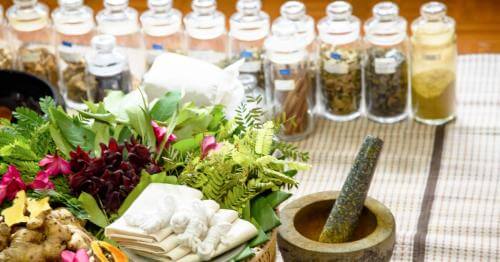 Take a look at the overview of all the recommended health treatments for each season (spring detoxification & summer rejuvenation & autumn immune boosting & winter regeneration) and find out how to take Ayurvedic treatments.
Take a look at the overview of all the recommended health treatments for each season (spring detoxification & summer rejuvenation & autumn immune boosting & winter regeneration) and find out how to take Ayurvedic treatments.
Shodhana Clinical Care
Shodhana represents a stricter purifying and detoxifying process known as Panchakarma, which is organised under the clinical supervision of a trained Ayurvedic doctor. The main difference between these two concepts lays in the method of treatment of the dosha imbalance. Home therapy Shamana pacifies disturbed doshas back to their natural state of balance, whereas Shodhana eliminates the aggravated doshas from the body. Shodhana is a special therapy to eliminate the causes of disease in case of advanced, long-term and chronic conditions. It is connected mainly with the thorough purification of the body and general detoxification. Such deeper cleansing therapy eliminates aggravated doshas and accumulated toxins from bodily tissues (dhatus) and circulatory channels (srotamsi). Consequently, they remove the germs causing further development of various diseases.
The main method is a purification procedure called Panchakarma, after which physical and mental health improves. This traditional Ayurvedic therapeutic procedure consists of five steps, which take place under the supervision of an experienced Ayurvedic physician:
5 Steps of Panchakarma
- Vomiting (vamana) decreases kapha dosha in case of chronic diseases of the upper and lower respiratory tract. They include coughs and colds, asthma, rhinitis, flu, bronchitis and phlegm in the stomach.
- Use of purgatives (virechana) eliminates accumulated pitta dosha in case of stomach acidity, initial phases of stomach and duodenal ulcers, allergies in the digestive tract, jaundice, skin disorders and rashes.
- Rinsing the intestines (vasthi), which is used to calm vata dosha in case of neurological disorders, paralysation, polio, multiple sclerosis, nerve inflammation, sciatica, back and spine pain, constipation, kidney stones, arthritis or rheumatism.
- Nasal cleansing (nasya) with herbal oils relieves the nasal and frontal cavities, headache, migraines, eye disorders and ear pain.
- Blood-letting (raktamoksha) eliminates excessive pitta dosha and is basically meant for blood purification in case of enlarged liver and spleen, skin disorders, rashes, acne and boils.

